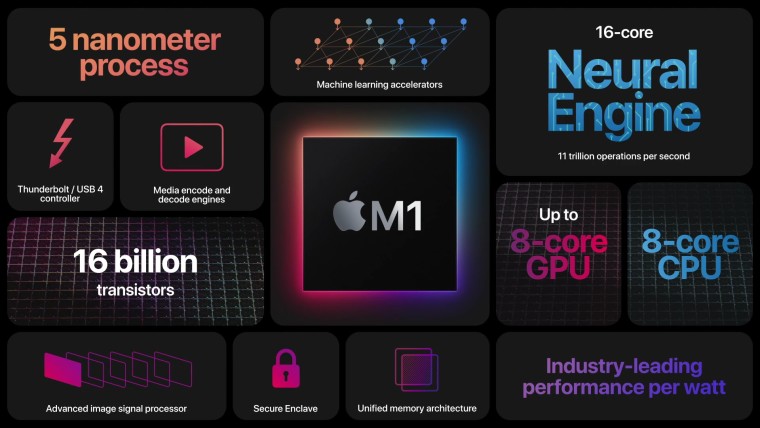
During its One More Thing event today, Apple introduced the first ARM-based chipset for MacBooks, the Apple M1. It's a low-power CPU that features an an octa-core CPU, with four high performance cores along with four power-efficient cores. It also has an octa-core GPU, 16 billion transistors, and a unified memory architecture, so every part of the chipset can access the device memory equally.
Since it uses a typical little-big architecture for ARM chipsets, the M1 can switch between the high-performance and power-efficient cores on the fly. Apple says the chip can reach the same performance as an existing PC chip at one quarter of the power. Apple claims it has the world's highest performance per watt.

As for the GPU, Apple says it has the world's fastest integrated graphics, claiming to be twice as fast as an existing PC chip, while still using less power.
In addition to having powerful hardware, Apple has also worked on the integration with macOS Big Sur. Thanks to the optimizations it's made, Apple says the Safari web browser now runs 1.5 times faster running JavaScript and "twice as responsive". Using Apple Silicon also means Macs now wake up instantly from sleep, and iPhone and iPad apps can run directly on macOS. All the built-in Mac apps also now run natively on Apple Silicon. Apple also announced that Adobe apps will run natively on Apple Silicon early next year.
The Apple M1 will debut at the heart of the new MacBook Air, which promises much better performance. Apple touts up to 3.5 times the CPU performance of the previous generation, 5 times the GPU performance, and 9 times the machine learning performance. The chipset also has a new flash memory controller, meaning it can deliver up to two times the SSD transfer speeds. What's more, Apple says the new MacBook Air is faster than 98% of PC laptops sold in the last year.

On top of that, the new MacBook Air leverages the new Apple Silicon to bring a new image signal processing pipeline to the webcam. This allows the webcam to do things such as noise reduction, face detection, and more.

In addition to that, the new MacBook Air does all of that without a cooling fan and with battery life up to 18 hours of battery life, the longest ever for a MacBook Air. Aside from that, the MacBook Air comes with a similar design, and the USB ports now support USB 4 and Thunderbolt. The laptop still starts at $999.
There's also a new 13-inch MacBook Pro, also featuring the Apple M1, with up to 2.8 times the CPU performance, 5 times the graphics performance, and 11 times the machine learning performance compared to the previous generation. It also promises be up to 3 times faster than competing Windows laptops in its class, all with up to 20 hours of battery life. It has new studio microphones with an improved signal-to-noise ratio and all the same improvements for the camera as the MacBook Air. Otherwise, it's the MacBook Pro you know, with the Touch Bar, Touch ID, and so on.
_story.jpg)
Just like the MacBook Air, the MacBook Pro 13-inch still starts at the same price despite the improvements, meaning it'll set you back $1299 at the base level.
Finally, the Apple M1 is inside the new Mac Mini, which promises 3 times faster CPU speeds, 6 times the GPU performance (with support for 6K displays), and 15 times the machine learning performance over the previous generation. In terms of ports, the new Mac Mini comes with two USB Type-A ports, two Thunderbolt/USB 4 ports, a 3.5mm headphone jack, HDMI 2.0, and Ethernet. The new Mac Mini starts at $699, $100 below the previous generation.
_story.jpg)
All of the new Macs are available to order today, and shipping starts next week.
















139 Comments - Add comment